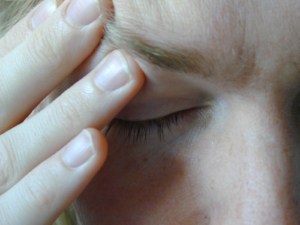If you have ever had a migraine headache, I’m sure you will agree that if you NEVER had another one,,,,,,,
you’d be good!
Do you know the mechanics of a Migraine?
The Science of a Migraine
According to scientists, the science of the migraine is not fully understood. They do know that it is a result from a complex series of abnormal events in the brain. And while not fully understood, they believe that the abnormal activity originates in the trigeminal nerve. It is the largest nerve in our head. Changes within this cranial nerve spread to the smaller network of nerves that form a web throughout the outer lining of the brain.
These arteries are wrapped with pain receptors. Over-dilation causes these receptors to be stretched, resulting in the intense pain and throbbing of a migraine. The pain is localized because of the limited area of over-dilation, while the throbbing results because each time the heart pumps blood into the artery, the artery expands. When the heart rests, the artery partially constricts which relieves the pain.
It can be as little as 10 minutes after a migraine begins, that the nerves in the network that sense pain, experience a molecular change. The change makes them very sensitive to pressure. It is believed that certain arteries dilate and blood flow is altered. As a result, chemicals are released that are pain-producing. Dopamine and serotonin, chemicals in our brain, are also believed to have a role in how a migraine develops.
Are your symptoms included here?
 About 12% of Americans suffer from them, and some experience pain so severe that it keeps them from being able to continue their day. Migraine headaches are usually one-sided, pulsating or throbbing, and moderate or severe in intensity. They can be worsened with activity and may be associated with nausea and/or vomiting, as well as sensitivity to light or noise. Some patients also experience auras, a neurological symptom that develops gradually over 5-20 minutes. The patient may see brief flashes or waves of light, or changes in their vision. Other common features of auras include vertigo, imbalance, confusion and numbness. My patients will often relate that they wanted to go into a dark room where it was quiet and no light.
About 12% of Americans suffer from them, and some experience pain so severe that it keeps them from being able to continue their day. Migraine headaches are usually one-sided, pulsating or throbbing, and moderate or severe in intensity. They can be worsened with activity and may be associated with nausea and/or vomiting, as well as sensitivity to light or noise. Some patients also experience auras, a neurological symptom that develops gradually over 5-20 minutes. The patient may see brief flashes or waves of light, or changes in their vision. Other common features of auras include vertigo, imbalance, confusion and numbness. My patients will often relate that they wanted to go into a dark room where it was quiet and no light.
.
Do you know what brings your migraine on?
There are several stimuli that are known to trigger a migraine to come on. These are some of the most common triggers.
- Muscular tension
- Foods; there are a range of foods that can potentially trigger a migraine. They are; fermented and pickled food, cured meats and aged cheeses, and some fruits, e.g. bananas, citrus, and avocado.
- Skipped meals
- Little or too much sleep
- Smells
- Fluctuating Hormone Levels, especially in women
- Stress and anxiety
- Fluctuations in atmospheric pressure
- Drinking alcohol or caffeine withdrawal
What’s the treatment protocol for migraines?
Western Medicine approach
 For the Western approach, the first line of defense is to take over the counter pain medications. If those aren’t effective, there is one main class of migraine prescription medication called Triptans. Unlike other acute medications, Triptans are considered selective serotonin receptor agonists. In layman words, triptans work to reduce inflammation and constrict blood vessels. Thereby stopping the headache or migraine. One challenge with triptans are that they are not safe for everyone.
For the Western approach, the first line of defense is to take over the counter pain medications. If those aren’t effective, there is one main class of migraine prescription medication called Triptans. Unlike other acute medications, Triptans are considered selective serotonin receptor agonists. In layman words, triptans work to reduce inflammation and constrict blood vessels. Thereby stopping the headache or migraine. One challenge with triptans are that they are not safe for everyone.
Botox is another approach that is pretty new as a way to address chronic migraines. The definition of chronic migraines, is that they occur for more than 15 days in a month.
Portland Acupuncture for migraines
Acupuncture has been used to treat headaches for thousands of years. The most significant advantage of acupuncture over western medicine is that it has no side effects. Another advantage is the procedures for treating headaches are much less invasive.
The treatment approach to migraines with acupuncture and Chinese herbs depends on the accompanying symptoms and the location of the pain in the head. This is another way Chinese medicine specifically addresses the patient’s unique presentation. There isn’t just one protocol for migraine treatment, but many, based on experience gained through acupuncture’s practice for hundreds of years.
Blood flow in the tissues increases when small vessels around the area of the needle dilate. Usually, treatments that increase circulation are highly effective for pain. However, that is not the case when treating the pain associated with migraines. At the beginning of this blog, I explained the that the pain of a migraine may be associated with the dilation of blood vessels in the head. This dilation increases circulation in this area and can worsen the patient’s symptoms. One way to accommodate this issue is to avoid points in the head, neck and upper body. In this way, dilating the blood vessels of the head is avoided. The entire treatment is performed with the patient laying face up rather than face down.
Where do you get your migraine?
There are 6 meridians on the lower limbs that are utilized for treatment, depending on the patient’s experience. If the migraine is in the forehead, points are chosen from the Spleen and Stomach meridians, because the underlying cause tends to be an issue in the digestive system. Herbs are chosen to help the body process more efficiently nutrients consumed.
If the migraine is at the top of the head, this is typically caused by an overactive response to stress, and the Liver meridian is addressed, since one of it’s main roles in Chinese medicine is to promote the smooth flow of emotions and qi all throughout the body. Optical migraines, creating pain around the eye and triggering visual changes or sensitivity to light, are also Liver related, since the eyes are the sensory organs that the Liver opens through.
Triggers such as alcohol, caffeine, and muscle tension can end up with referring pain here, or in the areas traversed by its paired meridian, the Gall Bladder. The Gall Bladder acupoints are lateral and superior to the eye, and affect the temples, a common area where pounding pain can pinpoint. Migraines at the occiput, the base of the back of the head also correspond to this meridian. Needles are placed in Gall Bladder acupoints further down the meridian, in the legs, to pull that stagnation and pain away. Kidney and Liver acupoints are chosen for hormonally caused migraines. The Bladder meridian travels along the entire back, so musculoskeletal pain there can cause trigger points which radiate into migraines. By choosing points lower on the Bladder meridian, again blockages can be dispersed and pain from above has somewhere to drain down and out.
If you are wondering if Acupuncture is an option for you, we are always happy to have a conversation with you, about your symptoms and how we can help you.
Ready for treatment?
Call 503-246-0103 to schedule an appointment.
Have a question?
To submit an inquiry to one of our professionals, email us at contact@riverwestacupuncture.com.Have a question about acupuncture or some of our other services? Send us your question and we’ll get back to you shortly with a reply!
